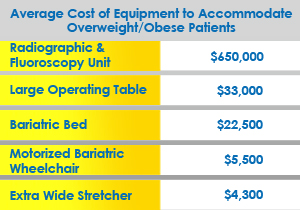| NYC Resources | 311 | Office of the Mayor |
|
|
Important notice on data breaches affecting some HHC patients |
As Patients' Waistlines Expand, So Do Costs to Accommodate Them
Patients and visitors to Jacobi Medical Center now have access to 40 new toilets specially designed to support up to 500 pounds. Harlem Hospital Center will soon purchase 197 beds with the same capacity. And at Bellevue Hospital Center, extra wide wheel chairs, larger linens and bigger stretchers have been the norm to care for obese patients in their Bariatric program. These hospitals are home to HHC’s three Centers of Excellence for Bariatric Surgery which traditionally care for morbidly obese patients. But HHC officials say they have also invested millions in the eight other public hospital facilities for special tools, equipment, supplies, infrastructure upgrades and staff training in order to accommodate a growing number of overweight New Yorkers who are getting primary and specialty care all across the public healthcare system. “We have made escalating investments to provide the medical care to growing number of overweight patients presenting with obesity-related conditions like diabetes, hypertension and congestive heart failure all across our system,” said HHC President Alan D. Aviles at a recent press conference where he joined Mayor Bloomberg and other health officials to discuss the health impact of obesity. “That care goes beyond having trained physicians and other clinical staff. It also translates into expensive modifications to physical infrastructure and costly specially sized equipment to accommodate patients and ensure their comfort and safety,” added Aviles. Obesity is a major public health crisis in America that is getting worse. Nearly 60 percent of New York City residents are currently overweight or obese. According to the Centers for Disease Control and Prevention, direct medical costs related to obesity have reached $147 billion a year across the U.S. And while HHC has no direct way to estimate the full costs of obesity for the system, officials say it clearly contributes significantly to the $348 million in estimated annual costs to care for HHC’s 58,000 diabetic patients, based on the national average of $6,000 per patient. There are similar costs associated with treating obesity-related hypertension and congestive heart failure. But those estimates of obesity-related chronic disease costs often do not take into account the necessary infrastructure and capital investments hospitals have to put in place, notes Antonio Martin, HHC Chief Operating Officer. “The cost of a hospital bed that is specifically designed for an obese patient is about three times the cost of a standard hospital bed,” said Martin. “And the price of an extra wide wheelchair is easily double the amount of a regular one.” Coney Island Hospital a few years ago purchased a special size radiographic fluoroscopy unit, a type of x-ray machine that provides real time moving images, to accommodate obese patients at a cost of $650,000. As with most HHC hospitals, they also have special lifts to help move patients, which ensure safety for both patients and staff. New operating tables with up to 750-pound capacity will cost Woodhull Medical and Mental Health Center and Lincoln Medical and Mental Health Center more than $33,000 each. And at Coler-Goldwater Specialty Hospital and Nursing Facility, the long-term care hospital and nursing home is including more than $715,000 in its budget to purchase new bariatric beds once its Goldwater campus moves to the former North General Hospital site in Harlem. HHC officials say that as they struggle to finance safe and high quality medical care to patients, it’s increasingly difficult to ignore the growing costs of obesity to the hospital system. “We care for 1.4 million patients each year and a startling high percentage of them are obese. That means a significant number of children, adolescents and adults will face short and long-term healthcare challenges and create a strain on healthcare spending at many levels.”
| ||||||
HHC 2014 Stats
- Staffed Beds: 6,684
- Clinic Visits: 4,472,960
- ER Visits: 1,179,436
- Discharges: 205,791
- Births: 18,564
| Copyright 2015 The City of New York | Contact Us | Privacy Policy | Terms of Use |


